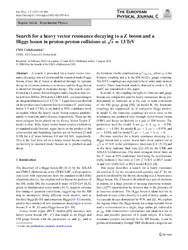Search for a heavy vector resonance decaying to a Z boson and a Higgs boson in proton-proton collisions at √s = 13 TeV
| dc.contributor.author | Sirunyan, A. M. | |
| dc.contributor.author | Işıldak, Bora | |
| dc.date.accessioned | 2023-05-10T06:51:21Z | |
| dc.date.available | 2023-05-10T06:51:21Z | |
| dc.date.issued | 2021-08-03 | |
| dc.identifier.issn | 1434-6044 | en_US |
| dc.identifier.uri | http://hdl.handle.net/10679/8225 | |
| dc.identifier.uri | https://link.springer.com/article/10.1140/epjc/s10052-021-09348-6 | |
| dc.description.abstract | A search is presented for a heavy vector resonance decaying into a Z boson and the standard model Higgs boson, where the Z boson is identified through its leptonic decays to electrons, muons, or neutrinos, and the Higgs boson is identified through its hadronic decays. The search is performed in a Lorentz-boosted regime and is based on data collected from 2016 to 2018 at the CERN LHC, corresponding to an integrated luminosity of 137fb-1. Upper limits are derived on the production of a narrow heavy resonance Z′, and a mass below 3.5 and 3.7Te is excluded at 95% confidence level in models where the heavy vector boson couples predominantly to fermions and to bosons, respectively. These are the most stringent limits placed on the Heavy Vector Triplet Z′ model to date. If the heavy vector boson couples exclusively to standard model bosons, upper limits on the product of the cross section and branching fraction are set between 23 and 0.3fb for a Z′ mass between 0.8 and 4.6Te, respectively. This is the first limit set on a heavy vector boson coupling exclusively to standard model bosons in its production and decay. | en_US |
| dc.description.sponsorship | BMBWF and FWF (Austria); FNRS and FWO (Belgium); CNPq, CAPES, FAPERJ, FAPERGS, and FAPESP (Brazil); MES (Bulgaria); CERN; CAS, MoST, and NSFC (China); COLCIENCIAS (Colombia); MSES and CSF (Croatia); RIF (Cyprus); SENESCYT (Ecuador); MoER, ERC PUT and ERDF (Estonia); Academy of Finland, MEC, and HIP (Finland); CEA and CNRS/IN2P3 (France); BMBF, DFG, and HGF (Germany); GSRT (Greece); NKFIA (Hungary); DAEandDST (India); IPM (Iran); SFI (Ireland); INFN (Italy); MSIP and NRF (Republic ofKorea); MES (Latvia); LAS (Lithuania); MOE and UM (Malaysia); BUAP, CINVESTAV, CONACYT, LNS, SEP, andUASLP-FAI (Mexico); MOS (Montenegro); MBIE (New Zealand); PAEC (Pakistan); MSHE and NSC (Poland); FCT (Portugal); JINR (Dubna); MON, RosAtom, RAS, RFBR, and NRC KI (Russia); MESTD (Serbia); SEIDI, CPAN, PCTI, and FEDER (Spain); MOSTR (Sri Lanka); Swiss Funding Agencies (Switzerland); MST (Taipei); ThEPCenter, IPST, STAR, and NSTDA (Thailand); TUBITAK and TAEK (Turkey); NASU (Ukraine); STFC (UK); DOE and NSF (USA). Individuals have received support from theMarie-Curie program and the European Research Council andHorizon 2020 Grant, contract nos. 675440, 724704, 752730, and 765710 (European Union); the Leventis Foundation; the Alfred P. Sloan Foundation; the Alexander von Humboldt Foundation; the Belgian Federal Science Policy Office; the Fonds pour la Formation a la Recherche dans l'Industrie et dans l'Agriculture (FRIA-Belgium); the Agentschap voor Innovatie doorWetenschap en Technologie (IWT-Belgium); the F.R.S.-FNRS and FWO (Belgium) under the "Excellence of Science - EOS" - be.h project n. 30820817; the Beijing Municipal Science and Technology Commission, no. Z191100007219010; the Ministry of Education, Youth and Sports (MEYS) of the Czech Republic; the Deutsche Forschungsgemeinschaft (DFG), under Germany's Excellence Strategy - EXC2121 "Quantum Universe" -390833306, and under project number 400140256 - GRK2497; the Lendulet ("Momentum") Program and the Janos Bolyai Research Scholarship of the Hungarian Academy of Sciences, the New National Excellence Program UNKP, the NKFIA research grants 123842, 123959, 124845, 124850, 125105, 128713, 128786, and 129058 (Hungary); the Council of Science and Industrial Research, India; the HOMING PLUS program of the Foundation for Polish Science, cofinanced from European Union, Regional Development Fund, the Mobility Plus program of the Ministry of Science and Higher Education, the National Science Center (Poland), contracts Harmonia 2014/14/M/ST2/00428, Opus 2014/13/B/ST2/02543, 2014/15/B/ST2/03998, and 2015/19/B/ST2/02861, Sonata-bis 2012/07/E/ST2/01406; the National Priorities Research Program by Qatar National Research Fund; the Ministry of Science and Higher Education, project no. 0723-2020-0041 (Russia); the Programa Estatal de Fomento de la Investigacion Cientifica y Tecnica de Excelencia Maria de Maeztu, grantMDM-2015-0509 and the Programa SeveroOchoa del Principado de Asturias; the Thalis and Aristeia programs cofinanced by EU-ESF and the Greek NSRF; the Rachadapisek Sompot Fund for Postdoctoral Fellowship, Chulalongkorn University and the Chulalongkorn Academic into Its 2nd Century Project Advancement Project (Thailand); the Kavli Foundation; the Nvidia Corporation; the SuperMicro Corporation; the Welch Foundation, contract C-1845; and the Weston Havens Foundation (USA). | |
| dc.language.iso | eng | en_US |
| dc.publisher | Springer | en_US |
| dc.relation.ispartof | The European Physical Journal C | |
| dc.rights | openAccess | |
| dc.rights.uri | https://creativecommons.org/licenses/by/4.0/ | |
| dc.title | Search for a heavy vector resonance decaying to a Z boson and a Higgs boson in proton-proton collisions at √s = 13 TeV | en_US |
| dc.type | Article | en_US |
| dc.description.version | Publisher version | en_US |
| dc.peerreviewed | yes | en_US |
| dc.publicationstatus | Published | en_US |
| dc.contributor.department | Özyeğin University | |
| dc.contributor.authorID | (ORCID 0000-0002-0283-5234 & YÖK ID 124605) Işıldak, Bora | |
| dc.contributor.ozuauthor | Işıldak, Bora | |
| dc.creator | The CMS Collaboration | |
| dc.identifier.volume | 81 | en_US |
| dc.identifier.issue | 8 | en_US |
| dc.identifier.wos | WOS:000692318100004 | |
| dc.identifier.doi | 10.1140/epjc/s10052-021-09348-6 | en_US |
| dc.identifier.scopus | SCOPUS:2-s2.0-85112669457 | |
| dc.relation.publicationcategory | Article - International Refereed Journal - Institutional Academic Staff |
Files in this item
This item appears in the following Collection(s)
Share this page




